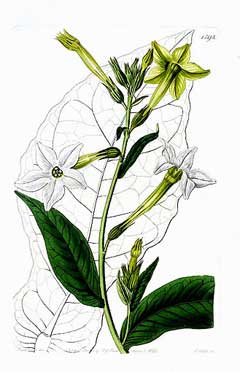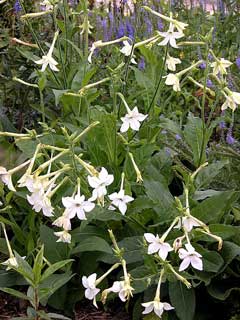 |
|
http://commons.wikimedia.org/wiki/File:Sydenham_Edwards1592.jpg |
 |
| http://www.flickr.com/people/65146221@N00 |
Translate this page:
Summary
Bloom Color: Pink, White. Main Bloom Time: Early summer, Early fall, Late summer, Late spring, Mid summer. Form: Upright or erect.
Physical Characteristics

 Nicotiana is a PERENNIAL growing to 0.6 m (2ft) by 0.3 m (1ft in) at a slow rate.
Nicotiana is a PERENNIAL growing to 0.6 m (2ft) by 0.3 m (1ft in) at a slow rate.
See above for USDA hardiness. It is hardy to UK zone 7 and is not frost tender. It is in flower from July to September, and the seeds ripen from August to October. The species is hermaphrodite (has both male and female organs) and is pollinated by Bees, Lepidoptera (Moths & Butterflies).
It is noted for attracting wildlife.
Suitable for: light (sandy), medium (loamy) and heavy (clay) soils and prefers well-drained soil. Suitable pH: mildly acid, neutral and basic (mildly alkaline) soils. It cannot grow in the shade. It prefers moist soil.
UK Hardiness Map
US Hardiness Map
Synonyms
Plant Habitats
Edible Uses
References More on Edible Uses
Medicinal Uses
Plants For A Future can not take any responsibility for any adverse effects from the use of plants. Always seek advice from a professional before using a plant medicinally.
None known
References More on Medicinal Uses
The Bookshop: Edible Plant Books
Our Latest books on Perennial Plants For Food Forests and Permaculture Gardens in paperback or digital formats.

Edible Tropical Plants
Food Forest Plants for Hotter Conditions: 250+ Plants For Tropical Food Forests & Permaculture Gardens.
More

Edible Temperate Plants
Plants for Your Food Forest: 500 Plants for Temperate Food Forests & Permaculture Gardens.
More

More Books
PFAF have eight books available in paperback and digital formats. Browse the shop for more information.
Shop Now
Other Uses
All parts of the plant contain nicotine, this has been extracted and used as an insecticide. Landscape Uses: Border, Container, Massing, Specimen. Dynamic accumulator.
Special Uses
References More on Other Uses
Cultivation details
Prefers a well-drained deep rich moist soil in a sunny position[1, 108]. Hardy to about -5°c[200], this plant is usually grown as an annual in Britain, flowering well in its first year, but it does survive mild winters outdoors[1]. A very ornamental plant[1], it has sweetly scented flowers that release most of their scent in the evening and attract moths[30]. Plant requires more than 14 hours daylight per day to induce flowering[169]. Special Features:Attracts birds, Not North American native, Naturalizing, All or parts of this plant are poisonous, Attracts butterflies, Suitable for cut flowers, Fragrant flowers, Attractive flowers or blooms.
References Carbon Farming Information and Carbon Sequestration Information
Temperature Converter
Type a value in the Celsius field to convert the value to Fahrenheit:
Fahrenheit:
The PFAF Bookshop
Plants For A Future have a number of books available in paperback and digital form. Book titles include Edible Plants, Edible Perennials, Edible Trees,Edible Shrubs, Woodland Gardening, and Temperate Food Forest Plants. Our new book is Food Forest Plants For Hotter Conditions (Tropical and Sub-Tropical).
Shop Now
Plant Propagation
Seed - surface sow in a warm greenhouse about 10 weeks before the last expected spring frosts. The seed usually germinates in 10 - 20 days at 20°c. Keep the soil moist and pot up as soon as the plants are big enough to handle, planting them out after the last expected frosts.
Other Names
If available other names are mentioned here
Native Range
SOUTHERN AMERICA: Brazil (Paraná, Rio Grande do Sul, Santa Catarina), Argentina (Corrientes, Entre Ríos, Misiones), Paraguay (east), Uruguay
Weed Potential
Right plant wrong place. We are currently updating this section.
Please note that a plant may be invasive in one area but may not in your area so it's worth checking.
Conservation Status
IUCN Red List of Threatened Plants Status :

Growth: S = slow M = medium F = fast. Soil: L = light (sandy) M = medium H = heavy (clay). pH: A = acid N = neutral B = basic (alkaline). Shade: F = full shade S = semi-shade N = no shade. Moisture: D = dry M = Moist We = wet Wa = water.
Now available:
Food Forest Plants for Mediterranean Conditions
350+ Perennial Plants For Mediterranean and Drier Food Forests and Permaculture Gardens.
[Paperback and eBook]
This is the third in Plants For A Future's series of plant guides for food forests tailored to
specific climate zones. Following volumes on temperate and tropical ecosystems, this book focuses
on species suited to Mediterranean conditions—regions with hot, dry summers and cool, wet winters,
often facing the added challenge of climate change.
Read More
Expert comment
Author
Link.&Otto.
Botanical References
200
Links / References
For a list of references used on this page please go here
Readers comment
| Add a comment |
|
If you have important information about this plant that may help other users please add a comment or link below. Only comments or links that are felt to be directly relevant to a plant will be included. If you think a comment/link or information contained on this page is inaccurate or misleading we would welcome your feedback at [email protected]. If you have questions about a plant please use the Forum on this website as we do not have the resources to answer questions ourselves.
* Please note: the comments by website users are not necessarily those held by PFAF and may give misleading or inaccurate information.
To leave a comment please Register or login here All comments need to be approved so will not appear immediately.
|
|